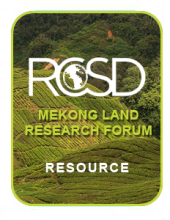Land Library Search
Through our robust search engine, you can search for any item of the over 73,000 highly curated resources in the Land Library.
If you would like to find an overview of what is possible, feel free to peruse the Search Guide.
/ library resources
Showing items 1 through 9 of 81.This paper reviews the literature to identify the relationship between tenure security and food security. The literatures on tenure issues and food security issues are not well connected and the scientific evidence on the causal links between tenure security and food security is very limited.
ABSTRACTED FROM EXECUTIVE SUMMARY: In the last decade it has become widely accepted that insecurity of land tenure has a unique impact on women, particularly in the global South where, more often than not, women are the primary caregivers in a household.
WEBSITE INTRODUCTION: Across the Mekong region, ‘development’ has become synonymous with rapid economic growth, to be achieved through predominantly large-scale, private investments.
Drawing on a survey of large-scale ecological restoration initiatives, we find that managers face contradictory demands. On the one hand, they have to raise funds from a variety of sources through competitive procedures for individual projects.
Protected areas (including areas that are nominally fully protected and those managed for multiple uses) encompass about a quarter of the total tropical forest estate.
Smallholders remain an important part of human-environment research, particularly in cultural and political ecology, peasant and development studies, and increasingly in land system and sustainability science.
Public participation theory assumes that empowering communities leads to enduring support for new initiatives. The New Zealand Biodiversity Strategy, approved in 2000, embraces this assumption and includes goals for community involvement in resolving threats to native flora and fauna.
The spatial distribution of crop and non-crop habitats over segmented agricultural landscapes could be used as a means to reduce insect pest populations.
This research was carried out in a dense tropical forest region with the objective of improving the biomass estimates by a combination of ALOS-2 SAR, Landsat 8 optical, and field plots data.


